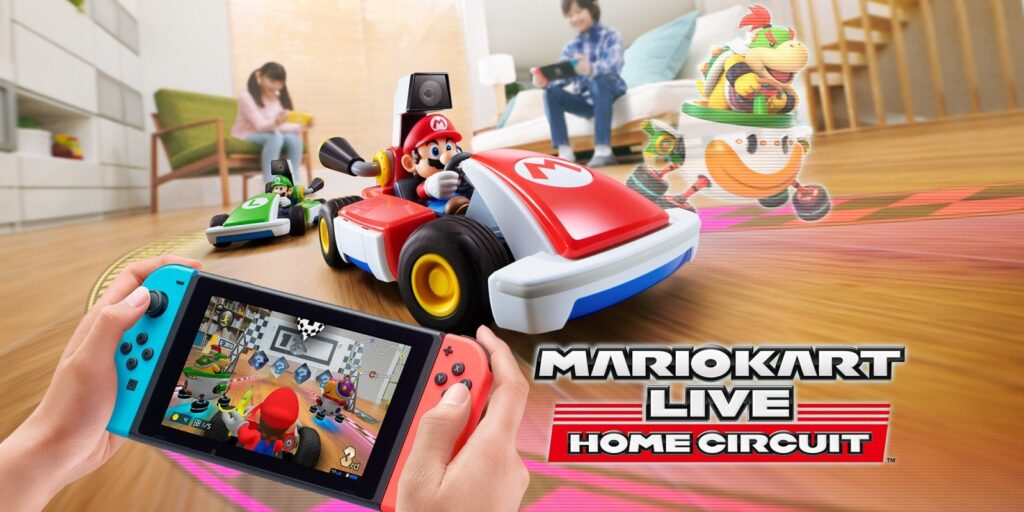
This month, Nintendo took another step into the augmented reality market with Mario Kart Live. It’s a Mario Kart game that utilizes real-life radio-controlled cars with a virtual reality track. It’s a toys-to-life approach that was popularized in the early 2010s by Skylanders: Spyro’s Adventure and Disney Infinity.
Reviewers have been fairly split on how good of a game Mario Kart Live actually is, but the general consensus is that it makes a fun augmented reality game and a less-than-exciting Mario Kartgame.
Whatever your opinion on it is, though, it’s impossible to talk about the game without imagining its larger impact on the AR market. For Lewis Ward, VR/AR specialist at analyst provider IDC, there is certainly a novel feeling to setting it up for the first time.
“First of all, it’s a great idea,” Ward told GameDaily. “It’s pretty intuitive to set it all up, and to create your own course and start racing. Maybe 30 minutes start to finish and to pair the Switch and the kart. So kudos to Nintendo for making it easy to get up and running.”
Ward said that in many ways, Mario Kart Live is an expansion of the Nintendo Labo idea of combining gameplay with tactile components and building. And while he hasn’t spent a ton of time with the game, he’s been entertained by its real-world approach to kart racing and the feeling that comes along with constructing your own tracks.
“I’m a fan of games that allow deep customization and even end-user generated levels and content like Dreams, Minecraft or Super Mario Maker 2,” he explained. “What I like about Mario Kart Live: Home Circuit is that your home becomes a canvas for a self-made course, and I’m sure people will come up with all sorts of crazy ways to make wild courses and will post them online. We have a five-year-old and she was pumped to see the kart race and it’s just all a bit magical to her. I bet that’s an outcome Nintendo was aiming for in the concept stage.”
As an analyst, though, Ward isn’t predicting astronomical sales numbers for Mario Kart Live, citing the fairly high cost of entry.
“I understand that you can have up to four actual karts in the same game, but of course that would get pretty spendy at around $100 each, plus the cost of four Switches,” he said. “At the current price point I doubt this will be a big seller for Nintendo. It’ll be a great holiday gift in some wealthier households and some hardcore Mario Kart 8 households, but I’ll be shocked if Mario Kart Live: Home Circuit shows up in Nintendo’s 4Q 2020 filing as one of its 1-million-plus-selling titles.
True to Ward’s analysis, Mario Kart Live didn’t figure heavily into the Q3 mixed reality (XR) report from SuperData. There are other variables that come into play, however, that may have a surprise impact on the game’s market performance. Namely, the strength of its community.
“I can imagine an esports event where this game is played,” Ward mused. “I haven’t taken this game anywhere near that deep, but I bet that’ll become ‘thing’ sooner or later, at least once strangers can congregate en masse again.”
The VR/AR market is an interesting one to monitor. The numbers aren’t nearly as high as the standard video game market, but investor interest remains substantial. Additionally, Nintendo has a reputation for its quirky and novel game concepts. They aren’t always runaway hits, but it’s impossible to deny the company’s penchant for the whimsical. In this way, Mario Kart Live is fascinating, and it will be interesting to see how it performs over the holiday season.
Sam, the Editor-in-Chief of GameDaily.biz, is a former freelance game reporter. He's been seen at IGN, PCGamesN, PCGamer, Unwinnable, and many more. When not writing about games, he is most likely taking care of his two dogs or pretending to know a lot about artisan coffee. Get in touch with Sam by emailing him at sdesatoff@rektglobal.com or follow him on Twitter.
 GameDaily.biz © 2025 | All Rights Reserved.
GameDaily.biz © 2025 | All Rights Reserved.